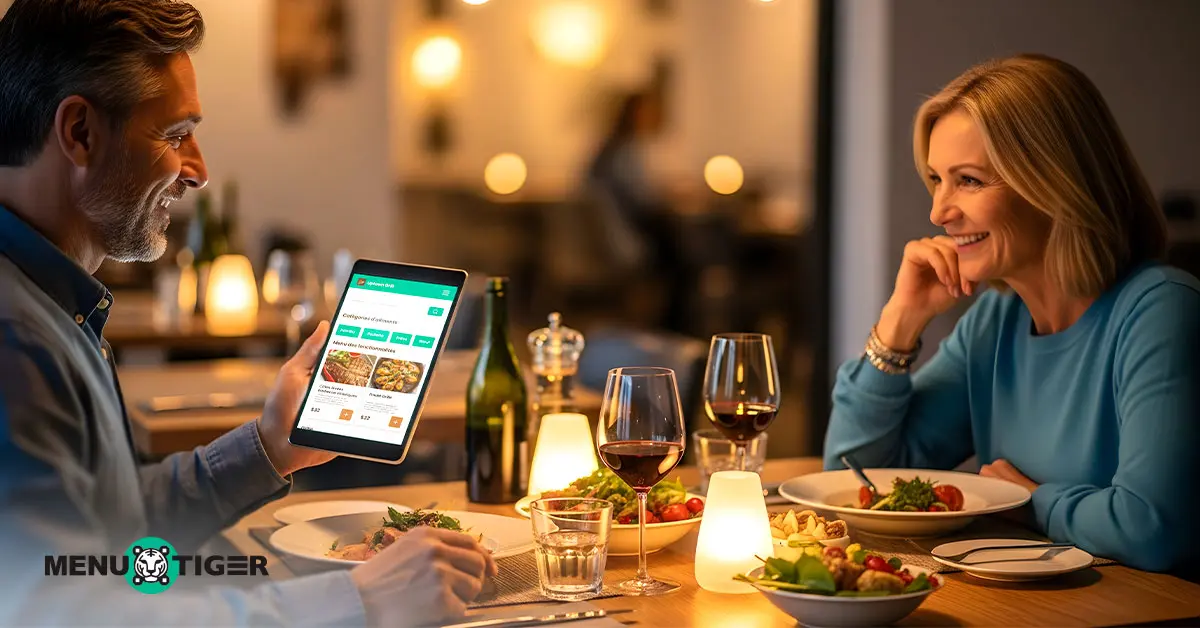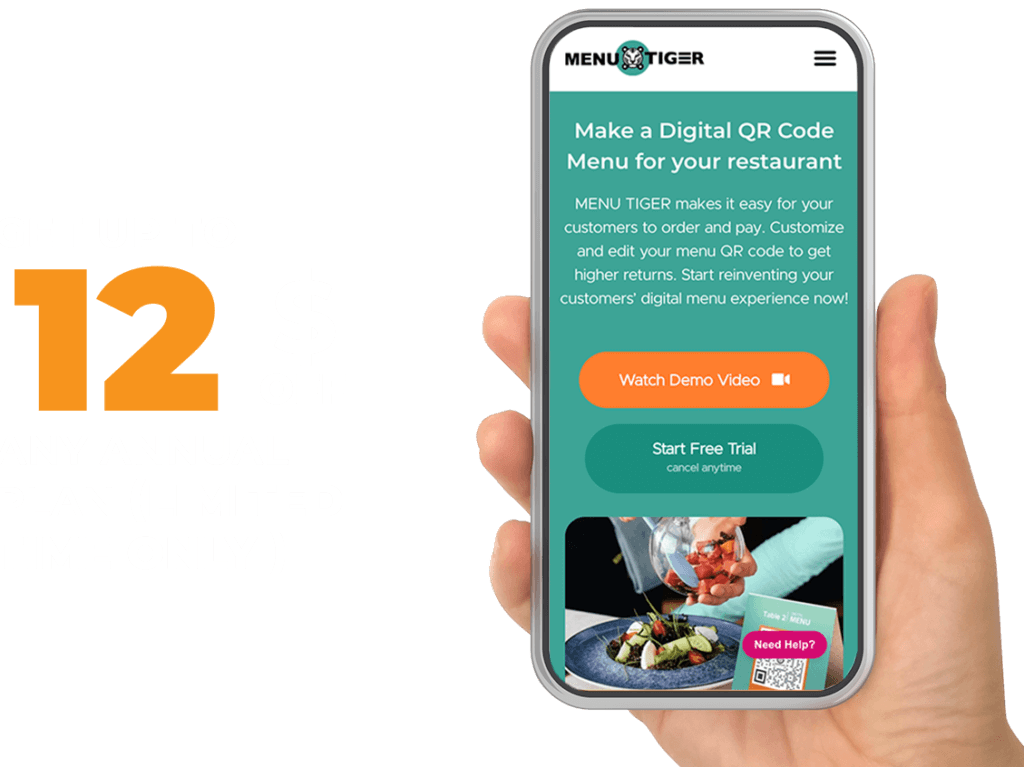Menu trends are a clear response to the inconveniences caused by outdated menus. And they emerged simply because they were seen as a benchmark for potential improvement.
For example, when the pandemic struck, paper menus were considered unhygienic due to their promotion of physical contact, and QR code menus replaced them.
This is all done with convenience, improvement, profit, and your struggle as a restaurant owner in mind.
This article presents a list of trending menus that you can utilize and implement in your restaurant to attract more customers by addressing their needs and preferences.
Table of Contents
ToggleThe innovative restaurant menu trends for your dishes
Who would have imagined that restaurant menus could go this far in design, technology, and creativity?
Menus have come a long way from simple printed sheets, and in 2025, they continue to evolve with innovations and convenience:
1. QR code menu
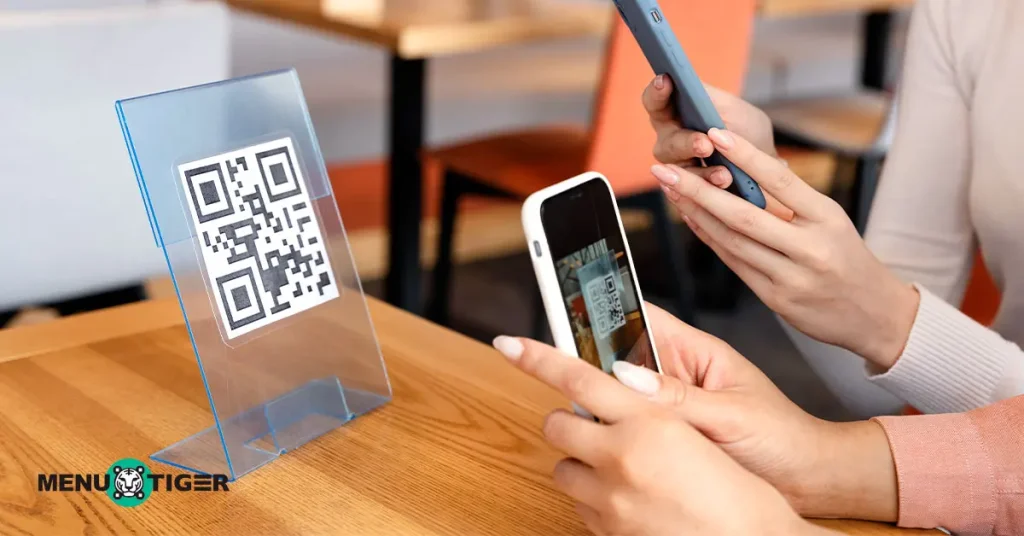
This format is the clear winner in the post-pandemic dining era due to its emphasis on touchless and hygienic practices.
Since then, QR menus have been widely adopted, according to the QR code menu forecast 2025.
Over 52% of U.S. restaurants have switched to them, and 78% of diners prefer to order through this menu. Customers love the convenience.
By simply scanning the QR code, they are presented with an interactive menu that allows them to browse popular menu items, place orders, and even add special instructions or modifiers.
2. Hybrid menus
Hybrids are the types of menu that combine two or more menu styles or service methods
These examples all aim to offer the best of both worlds. Most restaurants today, as they transition to technological advancements, still have customers who expect printed menus.
To help guests adapt to this change, restaurants have gradually introduced QR codes on printed menus.
For example, diners can learn more about each dish through printed materials, while QR codes placed beside the dishes allow them to see detailed information about the ingredients, their sources, and much more by simply scanning the code.
3. Self-service kiosk
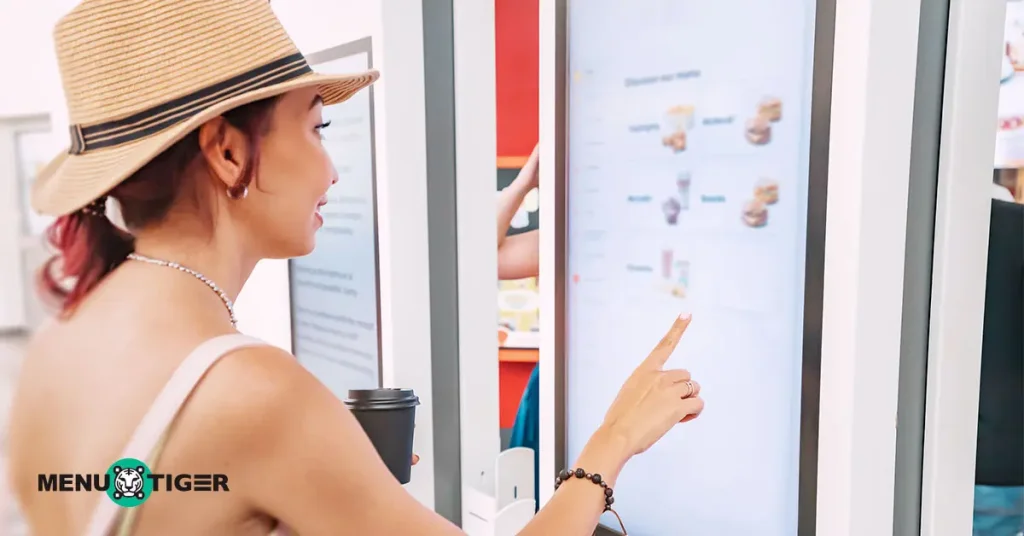
McDonald’s has by far the most self-ordering kiosks in the world, with about 70,000 machines.
The reason why self-service kiosks are widely used, especially in fast food chains, is because they help manage long customer lines more efficiently.
In fast-food chains that do not have self-service kiosks, it’s common to see a staff member walking along the line to take orders manually.
Customers are usually given paper tickets with their orders written on them, which they hand to the cashier once they reach the counter.
In busy locations, the counter alone often cannot accommodate the large number of people waiting to order.
Self-serve kiosk allows customers to place their orders on their own, reducing congestion at the counter and speeding up the overall service process.
4. Illustrated or hand-drawn menus
For a theme-based restaurant, this is perfect, as you can create a menu that matches your vibe through illustrations.
Some restaurants even paint their menus on the wall.
However, this type of menu usually remains static, with dishes offered consistently, since it is challenging to make gradual changes, especially if the menu is hand-drawn.
But if you follow the example of In-N-Out, a fast-food chain in the United States that keeps its menu consistent, you can create a museum-like menu, where creative artworks are displayed over time.
5. Menu boards
Long before online menu or kiosks, quick-service restaurants and fast-food chains used menu boards, and many still do today.
With restaurant POS system in place, the primary purpose of a menu board is to display all items clearly so customers can easily choose what they want and place the order directly on the counter.
Today, fast-food restaurants often use multiple types of menus: kiosks for those who want to order and pay digitally, and menu boards for those who prefer to order at the counter.
6. Augmented reality (AR) and interactive menus
One of the newest menu trends in 2025 is AR menus, which bring dishes to life in 3D. By scanning a QR code or using AR glasses, diners can view realistic, rotating images of meals before placing their order.
Tenshino Restaurant, a Japanese dining venue in Bangkok, Thailand, has successfully implemented a WebAR menu.
Their unique gimmick allows customers to scan a QR code on the placemat to unlock hidden AR content, creating an interactive and immersive dining experience.
7. Inclusive menus
An accessible digital menu is designed specifically for people with disabilities, ensuring that everyone can navigate, read, and order food independently.
This type of menu is not merely a trend but a must.
The Americans with Disabilities Act (ADA), passed in 1990, helps make this possible by promoting equality and inclusion.
By creating accessible menus, restaurants make dining more welcoming and respectful for all guests, because everyone deserves the chance to enjoy a meal with ease and dignity.

The menu item trends that shape 2025 food choices
Beyond the menu templates and its physical form, these are also the trendy restaurant menu items that you should focus on highlighting in your offerings:
8. Plant-based alternatives
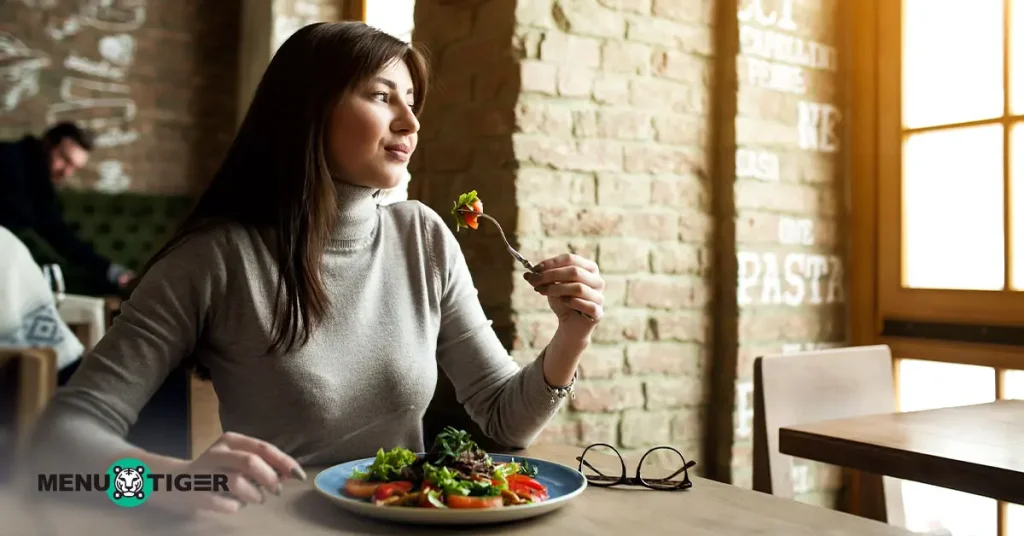
Let’s face it, everyone’s trying to be healthier. You see people hitting the gym, training for runs, and generally being more active.
Naturally, they want their food to help, not hurt, their goals. This is why easy healthy meals are booming.
It’s not just for vegans anymore; even people who love meat (the “flexitarians”) are swapping their meaty burger for a veggie one a few times a week just to keep a healthy balance.
The focus is now on celebrating vegetables and grains for what they are, not just trying to make them taste like beef.
9. Global flavors and fusions
Aside from migrants bringing their cuisines to new regions, social media has effectively removed all culinary borders, allowing people to enjoy foods like kimchi, sushi, tacos, and curry from anywhere in the world.
However, the trend isn’t just about awkwardly combining two cuisines; it’s about “Borderless Cuisine.”
This approach involves chefs thoughtfully and respectfully blending cooking techniques and ingredients from different cultures, such as using kimchi as a topping on a classic American burger.
10. Preservatives- and chemical-free
ABC News reported that the rally outside the WK Kellogg headquarters in Michigan happened because of concerns over food dyes and chemical preservatives.
Protestors demanded that Kellogg, the maker of Froot Loops cereal, remove artificial colors from its products.
One food activist stated, “I’m here for the moms, all the moms, who struggle to feed their children healthy food without added chemicals.”
Today, consumers are reading labels more than ever before. They’ve become total detectives when it comes to ingredients.
They’re avoiding anything that sounds artificial or overly processed, leading to a huge demand for meals that are as close to nature as possible, often described as handcrafted or artisanal.
11. Climate-conscious dining
It’s no secret that the health of the planet is on people’s minds. Diners, especially younger ones, want their food choices to reflect their values.
This trend is driving the popularity of ingredients from regenerative farming (which helps the soil) and zero-waste cooking techniques, where chefs use every part of a vegetable or animal.
People are actively seeking out and are willing to pay more for brands and restaurants that are open and honest about their sustainable practices.
12. ‘No-Lo’ drink
Today, while there are certainly many drinkers, the sober-curious crowd is growing rapidly, due to health consciousness.
People are seeking interesting, non-alcoholic beverages that go beyond plain water.
As a result, restaurants are now putting as much creativity and effort into their non-alcoholic drinks as they do into their cocktails, offering unique mocktails, functional tonics, and other innovative beverages.
13. Social media menu trends 2025
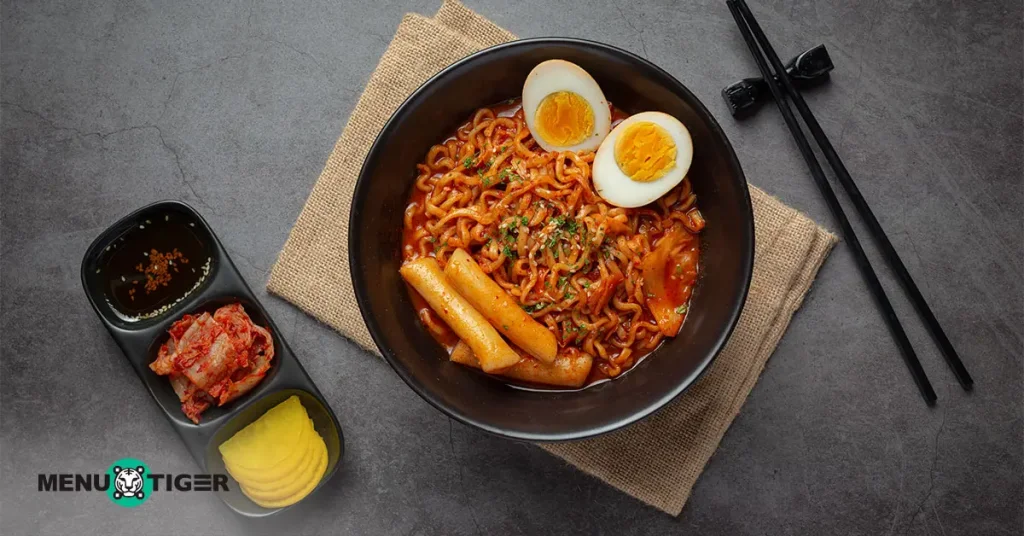
A research by Food Industry Executive, a trade publication and news, surveyed 1,000 U.S. consumers, and revealed that 75% of respondents are likely to try viral food and beverage trends they see on social media.
The spicy noodle challenge using Buldak noodles from Korea went viral online, and people began searching for them in their local areas up until today.
And sales of Buldak Ramen in the United States grew by 127% year-over-year, reaching $280 million after the products were stocked at major retailers like Walmart and Costco, says Korea JoongAng Daily, an English-language daily newspaper.
14. Comfort food revival
The world has been through a lot, and people are increasingly turning to food for emotional connection and a sense of security.
Restaurants are responding with nostalgic favorites like mac and cheese, loaded fries, and burgers with a modern twist that features premium, regional, and globally inspired ingredients and techniques.
For many, it is about healing the inner child. The goal is to create an emotional impact and evoke the familiarity of a classic while offering something fresh.
This trend shows street food growing. It is becoming more artful and refined, yet still delivering that deep, satisfying, feel-good experience that brings comfort with every bite.
15. Hyperlocal and seasonal sourcing
The days of simply saying “fresh” or “local” are over. Diners are now demanding hyper-transparency, wanting menus to specifically name the farms or gardens from which the ingredients were sourced.
This shift is not only about knowing what they are eating but also about understanding who they are supporting.
According to Market Intel, across much of the country, local farmers are struggling as crop prices fall and production costs remain high.
By highlighting hyperlocal and seasonal sourcing, restaurants can strengthen community ties, support small producers, and provide diners with a sense of authenticity and connection to every dish.
16. Coffee craze

NCAUSA.org published that approximately 66% of American adults will drink coffee daily in 2025, surpassing tea, juice, soda, and bottled water.
This represents a nearly 7% increase since 2020, with each coffee drinker consuming an average of three cups per day.
The popularity of viral drinks like Dalgona coffee and the consumption of matcha highlight evolving tastes.
Beyond the numbers, coffee trends are driven by functional drinks with protein or energy boosts, as well as flavor innovation featuring seasonal, indulgent creations that make coffee both a beverage and a dessert experience.
17. Homecooked eating
Despite the desire for restaurant experiences, the majority of Americans still prioritize eating home-cooked meals, with nearly nine in ten adults doing so at least a few times a week, as stated by Pew Research Center survey.
This preference is often driven by a perception that home-cooked meals are healthier and a way to save money amid rising food costs.
Since convenience alone cannot compete with the familiarity and value of home cooking, restaurants are responding by focusing on experiences over price, offering comfort food, and replicating dishes that evoke the warmth and satisfaction of meals made at home.
How to create the trending online menu for your restaurant
ZipDo, a digital restaurant insights source, claimed that 70% of consumers prefer ordering food through mobile apps, indicating a strong preference for digital ordering platforms.
These statistics highlight the demand for digital menus today. To meet this high demand, here’s how to create one in just a few simple steps:
1. Sign up or log in
Visit www.menutiger.com. Log in if you already have an account, or create a new one using your Google account or email and password.
2. Access the menu section
From the dashboard sidebar, click “Menus” in the top left corner. Then select “Add New” and choose whether to import an existing menu or start from scratch.
3. Build your menu from scratch
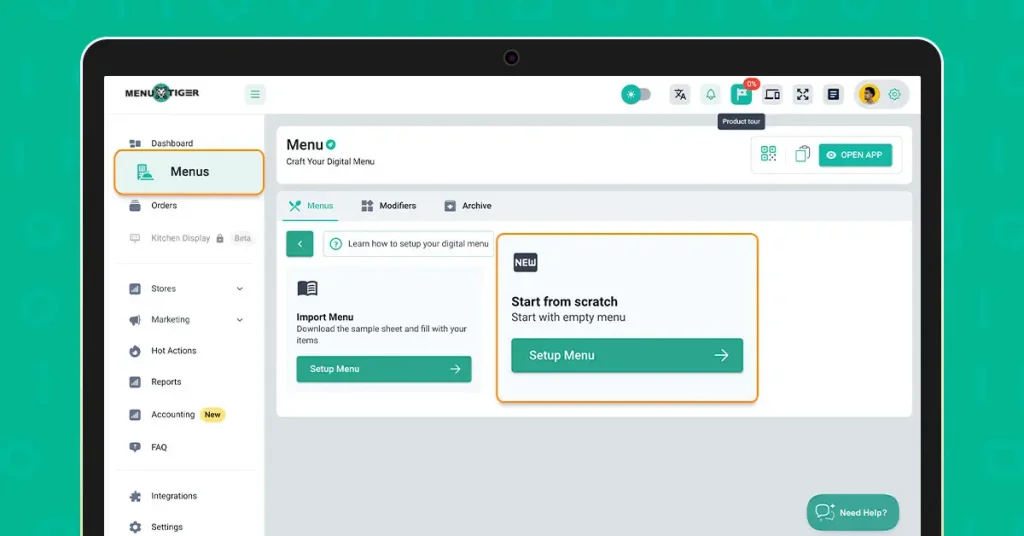
Click “Start from Scratch” to open the menu builder. Then enter a name and description for your menu.
4. Save your menu
Click “Save” to return to the main menu page. Your new menu will appear in the list, click it to start adding details.
5. Create menu categories
Click the “Add” button next to Categories to create a food or drink category.
Enter the category name and a short description, then click Save, and repeat for all necessary categories.
6. Add items to each category
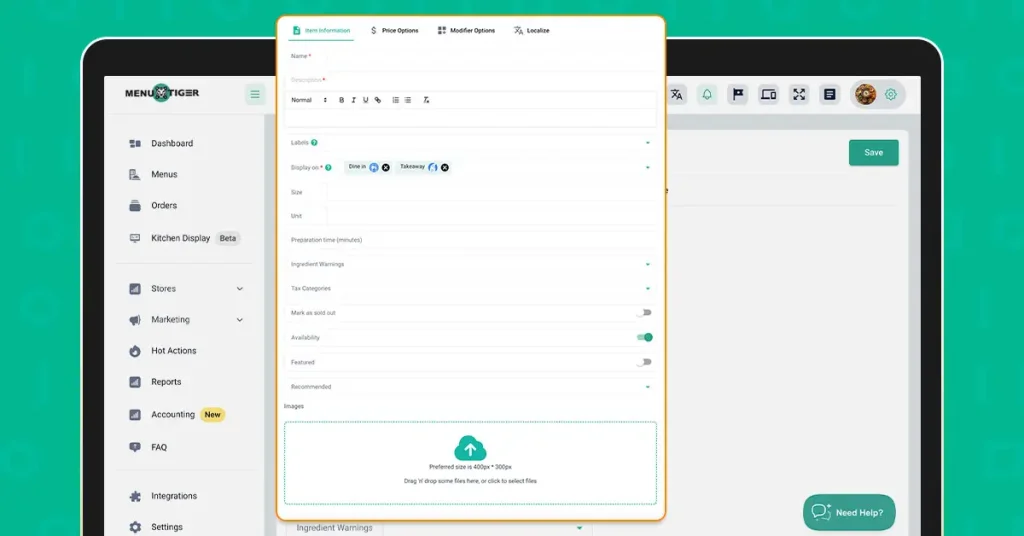
Open a category and click “Add Item” to include your dishes or drinks. Fill in the details for each menu item, such as name, description, and price.
7. Set up modifiers
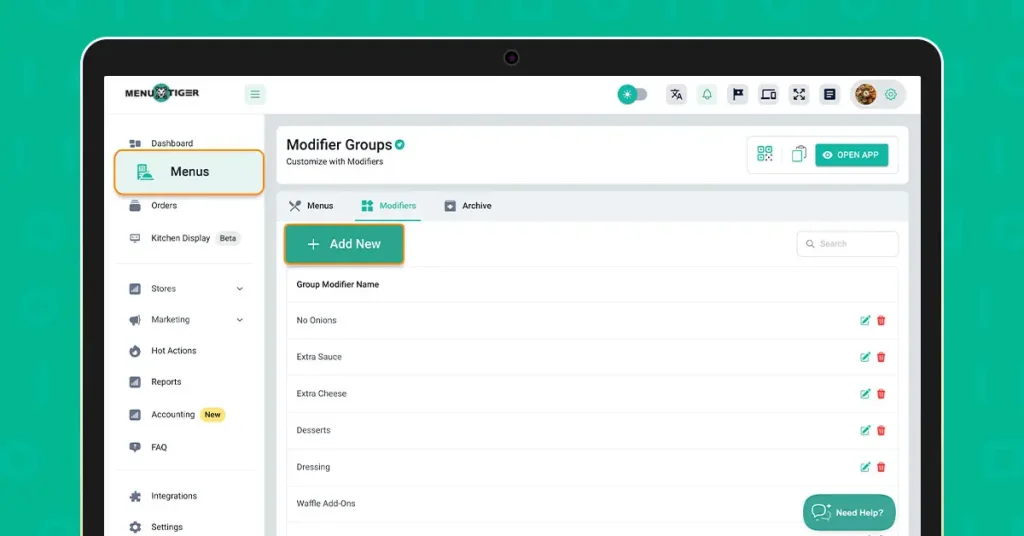
Go to the Modifiers section from the Main Menu. Enter the required details for each modifier (like extra toppings or sides). Once saved, these will appear alongside the relevant items on your menu.
8. Generate QR code
Once your menu is complete, MENU TIGER automatically creates QR codes linked to it. Simply go to Store Settings, connect your menu, and the platform will generate unique QR codes for each table.
Additional setup:
9. Kitchen Display System
The Kitchen Display System (KDS) will be connected to your menu. Once a customer places an order from your menu, it will automatically appear in the kitchen device.
You just need to have a compatible device and set it up as follows:
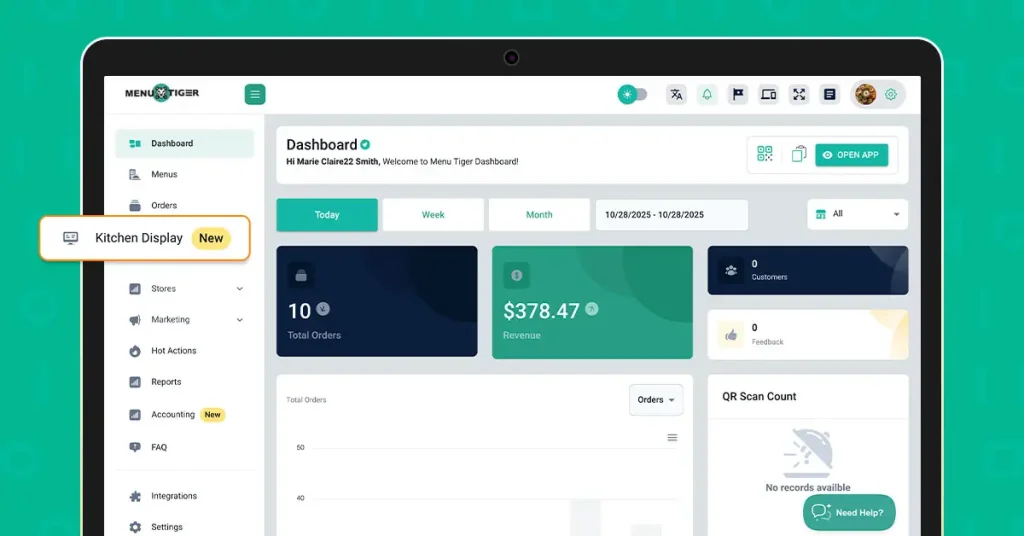
1. Go to KDS in your MENU TIGER dashboard sidebar.
2. Navigate to store settings and set the following:
- Display mode
- Transition time
- Fonts and colors
3. Assign your store to ensure orders are routed correctly and enable the desired order types.
4. Open the KDS to start processing orders. Orders will appear with modifiers, track preparation time, and automatically move to Completed when ready.

Turn your menu digital, trendy, and irresistible — start now!
In 2025, successful restaurants will be defined by their ability to integrate these menu trends seamlessly.
Whether it is the surging demand for technological convenience of menu management or health-conscious food choices, today’s diners want a menu that reflects their values and lifestyle.
By adopting a trendy menu, you can meet the needs of modern diners and attract a loyal, indispensable customer base for your restaurant.
So, don’t wait for your current menu to become one of those outdated inconveniences. Start building that trendy, digital experience now.
FAQs
A menu trend is a popular dish, ingredient, or style that restaurants include on their menus to attract customers and stay current with changing tastes. It reflects what diners are looking for and helps restaurants remain relevant in a competitive market.
Gen Z tends to favor healthy, sustainable, and visually appealing food. Popular trends for this generation include plant-based dishes, global and fusion flavors, and functional foods with added health benefits such as probiotics or energy-boosting ingredients.
Current food trends include plant-based and alternative proteins, locally sourced ingredients, bold fusion flavors, modern twists on comfort foods, and health-focused options like low-sugar or high-protein items. These trends reflect what consumers want in taste, health, and sustainability.
food trends become popular because they meet evolving consumer preferences, offer novelty and excitement, satisfy demands for convenience or sustainability, and gain widespread visibility through social media, influencers, and online sharing.

